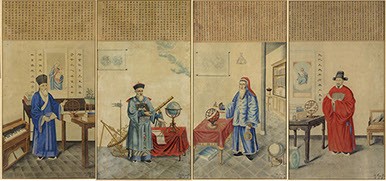Chinese Jesuit Portraits
These four large portraits from the Ricci Institute collection depict three Jesuits, Matteo Ricci, Johann Adam Schall von Bell, and Ferdinand Verbiest, and the eminent Ming scholar and patron of Ricci, Paul Xu Guangqi (Hsü Kuang-ch'i; a convert to Catholicism, though not a Jesuit.) Learn more about the images and their subjects.

The Paintings
These works were painted at the Jesuit orphanage art school at Xujiahui (徐家匯), often better known among Western historians by the local pronunciation and spelling (Zikawei). The paintings were completed in 1914 for a collection of arts and crafts items representing the newly formed Republic of China at the 1915 Panama-Pacific International Exposition held the following year in San Francisco. The Palace of Fine Arts still stands in the Marina District of San Francisco, where this huge world’s fair was held. The paintings are done in traditional Chinese watercolors on paper. We do not know how they were originally mounted, or if they were mounted as scrolls or fixed portraits. But apparently soon after their arrival in San Francisco in 1915 they were directly affixed to cedar boards without frame or glazing. Because of their size (58" x 30") it proved impractical to remount them on scrolls. The paintings were restored and reframed in 1997 by the Ricci Institute.

The Artist
We have no information about the artist or artists who painted these portraits. In the lower corner of three appears the name On (Ou?) Tsing Zé and the fourth, On (Ou?) Zeng Sun. The spelling follows the French romanization system used by the Shanghai Jesuit community at the turn of the century, but here they are representing the Shanghai dialect. No Chinese characters for this name appear, and whether the first word is On or Ou (Wu) is uncertain. Thus it might be either a personal name or sobriquet, or a studio place-name, i.e. An Qing Shan. Each subject is depicted in his familiar attire, surrounded by the religious, scientific, and musical objects through which they achieved renown. At the head of each painting is a biography written by Xia Dingyi, with one dated Minguo 3 [1914]. At the foot of each painting after the signature are the letters T.S.W. for T'ou-s é-wéi (Tushanwan), the location of the orphanage workshops. Although not distinguished art, the portraits have great charm and have been enjoyed by visitors to the Institute for many years.
Sources
The library at Zikawei contained a 1736 edition of the Description géographique, historique, chronologique, politique, et physique de l'empire de la Chine et de la Tartarie chinoise (Vol. 3) by Jean-Baptiste Du Halde which contains engravings depicting the four figures that are the subject of these portraits (a folded tryptich of Ricci, Schall, and Verbiest bound in after p.86, and another after p.120 showing Xü, his convert grand-daughter Candida who founded the Orphanage, and other material.) Based on the many nearly exact correspondences between the treatment of the figures and their accompanying attributes in the orphanage paintings it is highly likely, though not absolutely certain, that the artist of the portraits based his own depictions on Du Halde's. The actual Zikawei library copy of Du Halde which would have been the artist's inspiration is now part of the Institute's collection and reference images from it are included in each section to demonstrate the connection between Du Halde's work and that of the anonymous artist of these portraits.
Acknowledgement
The digital preservation of the paintings was made possible by the Thomas J. Klitgaard Endowment at the Ricci Institute and the Beijing Center for Language and Culture. Photo reproductions of the portraits are on permanent display at the Guangqi Park in Shanghai, China.


